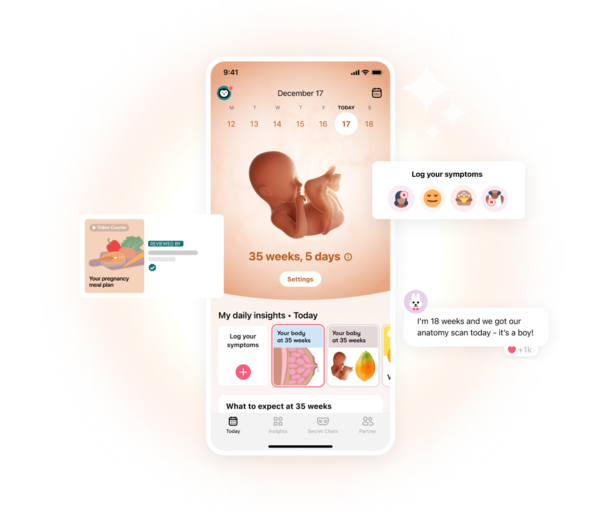-
Tracking cycle
-
Getting pregnant
-
Pregnancy
-
Help Center
-
Flo for Partners
-
Anonymous Mode
-
Flo app reviews
-
Flo Premium New
-
Secret Chats New
-
Symptom Checker New
-
Your cycle
-
Health 360°
-
Getting pregnant
-
Pregnancy
-
Being a mom
-
LGBTQ+
-
Quizzes
-
Ovulation calculator
-
hCG calculator
-
Pregnancy test calculator
-
Menstrual cycle calculator
-
Period calculator
-
Implantation calculator
-
Pregnancy weeks to months calculator
-
Pregnancy due date calculator
-
IVF and FET due date calculator
-
Due date calculator by ultrasound
-
Medical Affairs
-
Science & Research
-
Pass It On Project New
-
Privacy Portal
-
Press Center
-
Flo Accuracy
-
Careers
-
Contact Us
What Are Pregnancy Stretch Marks? Causes and Treatments


Every piece of content at Flo Health adheres to the highest editorial standards for language, style, and medical accuracy. To learn what we do to deliver the best health and lifestyle insights to you, check out our content review principles.
What are stretch marks?
They’re long, pink/red/brown scarring streaks that form when your skin expands or shrinks rapidly. This abrupt change leads essential skin proteins, specifically collagen and elastin, to rupture. Stretch marks develop as the skin begins to heal.
Initially itchy, thin, and pink in color, stretch marks turn into long, reddish-brown streaks. They tend to gradually fade to white or gray, and typically appear around the breasts, abdomen, buttocks, and thighs. There is some variation in appearance from one individual to the next.
Stretch marks occur in roughly 90 percent of pregnant women. Research shows that women with a larger abdominal circumference, higher body mass index before pregnancy, and greater weight gain are particularly susceptible. Other contributing factors include family history, age (younger moms are more likely to have them), and whether or not you’re carrying twins.
Although they affect physical appearance to some extent, stretch marks do not negatively impact your health.
Are pregnancy stretch marks permanent?
Since stretch marks are a form of scarring, they can never be completely removed from your skin. However, they have been known to fade over time, and certain treatments make them less noticeable.
When do stretch marks appear during pregnancy?
Most pregnant women usually spot stretch marks in the final trimester, around the sixth or seventh month. In rare cases, stretch marks may present themselves as soon as the expectant mother’s abdomen starts to grow.
Stretch marks on thighs
Pronounced weight gain and skin stretching normally occurs in the thighs and legs during pregnancy. This is why stretch marks often develop on the inner and upper thighs, as well as behind the knees.
Stretch marks on stomach
Pregnancy stretch marks are prevalent in the abdominal area as the skin in this region undergoes the most dramatic expansion. They’ll become increasingly noticeable as your baby bump continues to grow.
What causes stretch marks during pregnancy?
There are a number of reasons for stretch marks to form while you’re carrying your baby, which include:
- Physical stretching: Sudden expansion of the skin and weight fluctuations happen in the second trimester of pregnancy. Since these changes are abrupt, the skin around the breasts, abdomen, buttocks, and thighs do not have adequate time to adjust. This leads to a rupturing of the skin’s surface.
- Elastin and collagen: These proteins play a crucial role in promoting and maintaining your skin’s resilience and elasticity. Pregnancy alters elastin and collagen, upping your skin’s sensitivity.
- Hormones: Increases and decreases in hormone levels during pregnancy also play a key role in encouraging the formation of stretch marks.
Do stretch marks fade after pregnancy?
While pregnancy stretch marks tend to be very apparent in the final trimester, they slowly begin to fade after delivery. You may even see them turning a bit lighter in color on their own.
How to treat pregnancy stretch marks

Take a quiz
Find out what you can do with our Health Assistant
Although it’s impossible to completely rid your body of pregnancy stretch marks, there are a few products which serve as a remedy for stretch marks. Note that these should not be used during pregnancy, but only after your body’s fully healed and your doctor gives the green light.
- Retinol cream: Derived from vitamin A, it stimulates the production of collagen and takes up to 4 weeks to produce visible results. As with any topical cream, consult a medical professional first, and avoid using it while pregnant.
- Microdermabrasion: Also known as microneedling, it uses aluminum oxide crystals or other abrasive substances to remove the uppermost layer of skin. This reveals the fresh, scar-free surface below.
- Laser therapy: Studies show it’s one of the most effective treatments available for stretch marks. Laser therapy can be quite expensive, however, and may require multiple sessions.
How to prevent stretch marks during pregnancy
As previously mentioned, pregnancy stretch marks are caused by sudden weight gain and skin expansion. But by taking certain precautions, you may be able to lessen the effects on your body. Consider doing the following:
Applying natural topical creams
Specially formulated creams containing jojoba oil, shea butter, hyaluronic acid, onion, and aloe vera could prevent pregnancy stretch marks. Use twice a day beginning with the third month of pregnancy. By being proactive, you can maximize the product’s effectiveness, which drastically decreases once stretch marks become visible.
Choose odorless topical creams composed of natural ingredients which are easily absorbed by your skin. Note that different products might be required to treat different areas of the body.
Staying well-hydrated
Drink plenty of fluids as it keeps your skin soft, supple, and elastic. Dehydrated skin is more prone to developing stretch marks.
Eating a balanced diet
By maintaining a healthy, well-balanced diet, you can add those pregnancy pounds at a slower, steadier rate. You’ll thereby reduce your chances of forming pregnancy stretch marks in the process.
Increasing vitamin C intake
Vitamin C-rich fruits and vegetables contain antioxidants which repair skin and tissue damage. Incorporate oranges, tomatoes, broccoli, cauliflower, Brussels sprouts, spinach, and other leafy greens into your meals.
Massaging your skin
Gentle massages of the areas where pregnancy stretch marks are likely to pop up might also be beneficial. Focus on the breast, abdomen, buttock, and thigh regions.
Doing light exercise
Stay active to avoid huge fluctuations in body weight. Additionally, regular exercise boosts circulation and blood flow to your skin, making it less vulnerable to damage.
The development of pregnancy stretch marks may be troublesome, but there are several steps you can take to prevent and minimize their appearance. Just remember to consult your doctor before starting any type of treatment.


Hey, I'm Anique
I started using Flo app to track my period and ovulation because we wanted to have a baby.


The Flo app helped me learn about my body and spot ovulation signs during our conception journey.


I vividly
remember the day
that we switched
Flo into
Pregnancy Mode — it was
such a special
moment.
Real stories, real results
Learn how the Flo app became an amazing cheerleader for us on our conception journey.
References
History of updates
Current version (14 April 2020)
Published (10 July 2019)
In this article

Get your personal guide to pregnancy with the Flo app
-
Follow your baby's growth week by week
-
Get expert info on symptoms, safe foods, and more
-
Chat with other parents-to-be




